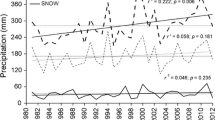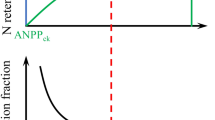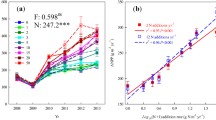Abstract
Aims
Changes in both rainfall patterns and nitrogen (N) deposition affect plant productivity. However, the knowledge of the interactions between reduced rainfall amount, reduced rainfall frequency, and increased atmospheric N deposition in grasslands is limited.
Methods
A three-factorial mesocosm experiment was conducted with monocultures of Leymus chinensis (Trin.) Tzvel. Treatments of rainfall amount (control, −30%), rainfall frequency (control, −50%) and N (0, 10 g N m−2 yr−1) were included.
Results
In the Songnen grassland, the aboveground net primary productivity (ANPP) of L. chinensis increased by 137% with N addition, decreased by 22% with reduced rainfall amount and increased by 74% with reduced rainfall frequency. Rainfall amount, but not frequency, had significant interaction with N treatment. The combined treatment of N addition and reduced rainfall amount increased ANPP by 46%. The shoot density was decreased by 35% with reduced rainfall amount, but increased by 45% with reduced rainfall frequency and by 67% with N addition. Nitrogen addition increased net carbon assimilation rate and water use efficiency (WUE), but they showed no significant response to main factors of altered rainfall changes except the increased WUE under reduced rainfall amount.
Conclusions
Shoot density rather than shoot biomass of L. Chinensis, is the key factor affecting ANPP in response to changes in rainfall pattern and N deposition, and ANPP was co-limited by water and N. The Songnen grassland will be resilient in ANPP in future climate change scenarios, because deeper water infiltration following reduced rainfall frequency can offset the reduced ANPP caused by reduced rainfall. This offset will be further enhanced by the higher WUE caused by increased atmospheric N deposition.




Similar content being viewed by others
References
Berry RS, Kulmatiski A (2017) A savanna response to precipitation intensity. PLoS One 12:e0175402
Bharath S, Borer ET, Biederman LA, Blumenthal DM, Fay PA, Gherardi LA, Knops JMH, Leakey ADB, Yahdjian L, Seabloom EW (2020) Nutrient addition increases grassland sensitivity to droughts. Ecology 101:e02981
Cao JR, Pang S, Wang QB, Williams MA, Jia X, Dun SS et al (2020) Plant-bacteria-soil response to frequency of simulated nitrogen deposition has implications for global ecosystem change. Funct Ecol 34:723–734
Didiano TJ, Johnson MTJ, Duval TP (2016) Disentangling the effects of precipitation amount and frequency on the performance of 14 grassland species. PLoS One 11:e0162310
Dong G, Guo JX, Chen JQ, Sun G, Gao S, Hu LJ, Wang YL (2011) Effects of spring drought on carbon sequestration, evapotranspiration and water use efficiency in the Songnen meadow steppe in Northeast China. Ecohydrology 4:211–224
Dukes JS, Chiariello NR, Cleland EE, Moore LA, Shaw MR, Thayer S et al (2005) Responses of grassland production to single and multiple global environmental changes. PLoS Biol 3:e319
Dziedek C, Fichtner A, Calvo L, Marcos E, Jansen K, Walmsley D, Haerdtle W (2017) Phenotypic plasticity explains response patterns of European beech (Fagus sylvatica L.) saplings to nitrogen fertilization and drought events. Forests:8:91
Felton AJ, Slette IJ, Smith MD, Knapp AK (2019a) Precipitation amount and event size interact to reduce ecosystem functioning during dry years in a Mesic grassland. Glob Chang Biol 26:658–668
Felton AJ, Sam ZP, Smith MD (2019b) Semiarid ecosystem sensitivity to precipitation extremes: weak evidence for vegetation constraints. Ecology 100:e02572
Fu G, Shen ZX (2016) Response of alpine plants to nitrogen addition on the Tibetan plateau: a meta-analysis. J Plant Growth Regul 35:974–979
Gao S, Wang JF, Zhang ZJ, Dong G, Guo JX (2012) Seed production, mass, germinability, and subsequent seedling growth responses to parental warming environment in Leymus chinensis. Crop Pasture Sci 63:87–94
Gherardi LA, Sala OE (2019) Effect of interannual precipitation variability on dryland productivity: a global synthesis. Glob Chang Biol 25:269–276
Gilbert B, MacDougall AS, Kadoya T, Akasaka M, Bennett JR, Lind EM, Flores-Moreno H, Firn J, Hautier Y, Borer ET, Seabloom EW, Adler PB, Cleland EE, Grace JB, Harpole WS, Esch EH, Moore JL, Knops J, McCulley R et al (2020) Climate and local environment structure asynchrony and the stability of primary production in grasslands. Glob Ecol Biogeogr 29:1177–1188
Greaver TL, Clark CM, Compton JE, Vallano D, Talhelm AF, Weaver CP, Band LE, Baron JS, Davidson EA, Tague CL, Felker-Quinn E, Lynch JA, Herrick JD, Liu L, Goodale CL, Novak KJ, Haeuber RA (2016) Key ecological responses to nitrogen are altered by climate change. Nat Clim Chang 6:836–843
Gruber N, Galloway JN (2008) An earth-system perspective of the global nitrogen cycle. Nature 451:293–296
Han JJ, Chen JJ, Shi WY, Song J, Hui DF, Ru JY, Wan SQ (2021) Asymmetric responses of resource use efficiency to previous-year precipitation in a semi-arid grassland. Funct Ecol 35:807–814
Hao YB, Zhou CT, Liu WJ, Li LF, Kang XM, Jiang LL, Cui XY, Wang YF, Zhou XQ, Xu CY (2017) Aboveground net primary productivity and carbon balance remain stable under extreme precipitation events in a semiarid steppe ecosystem. Agric For Meteorol 240-241:1–9
Harpole WS, Ngai JT, Cleland EE, Seabloom EW, Borer ET, Bracken ME, Elser JJ, Gruner DS, Hillebrand H, Shurin JB, Smith JE (2011) Nutrient co-limitation of primary producer communities. Ecol Lett 14:852–862
He CE, Liu XJ, Fangmeier A, Zhang FS (2007) Quantifying the total airborne nitrogen input into agroecosystems in the North China plain. Agric Ecosyst Environ 121:395–400
Heisler-White JL, Blair JM, Kelly EF, Harmoney K, Knapp AK (2010) Contingent productivity responses to more extreme rainfall regimes across a grassland biome. Glob Chang Biol 15:2894–2904
Hoover DL, Duniway MC, Belnap J, Cornwell W (2017) Testing the apparent resistance of three dominant plants to chronic drought on the Colorado plateau. J Ecol 105:152–162
IPCC (2013) Climate change 2013: the physical science basis. Contribution of working group I to the fifth assessment report of the intergovernmental panel on climate change. Cambridge University Press, Cambridge
Lin JX, Wang YN, Sun SN, Mu CS, Yan XF (2017) Effects of arbuscular mycorrhizal fungi on the growth, photosynthesis and photosynthetic pigments of Leymus chinensis seedlings under salt-alkali stress and nitrogen deposition. Sci Total Environ 576:234–241
Liu BH, Xu M, Henderson M, Qi Y (2005) Observed trends of precipitation amount, frequency, and intensity in China, 1960-2000. J Geophys Res 110:D08103
Liu C, Wang L, Song XX, Chang Q, Frank DA, Wang DL, Li JX, Lin HJ, Du FY (2018) Towards a mechanistic understanding of the effect that different species of large grazers have on grassland soil N availability. J Ecol 106:357–366
Lü XT, Liu ZY, Hu YY, Zhang HY (2018) Testing nitrogen and water co-limitation of primary productivity in a temperate steppe. Plant Soil 432:119–127
Meyer-Grunefeldt M, Belz K, Calvo L, Marcos E, von Oheimb G, Hardtle W (2016) Marginal Calluna populations are more resistant to climate change, but not under high-nitrogen loads. Plant Ecol 217:111–122
Morillas L, Duran J, Rodriguez A, Roales J, Gallardo A, Lovett GM, Groffman PM (2015) Nitrogen supply modulates the effect of changes in drying-rewetting frequency on soil C and N cycling and greenhouse gas exchange. Glob Chang Biol 21:3854–3863
Nielsen UN, Ball BA (2015) Impacts of altered precipitation regimes on soil communities and biogeochemistry in arid and semi-arid ecosystems. Glob Chang Biol 21:1407–1421
Novair SB, Hosseini HM, Etesami H, Razavipour T (2020) Rice straw and composted azolla alter carbon and nitrogen mineralization and microbial activity of a paddy soil under drying-rewetting cycles. Appl Soil Ecol 154:103638
Pinheiro J, Bates D, DebRoy S, Sarkar D, R Core Team (2021) Nlme: linear and nonlinear mixed effects models. https://CRAN.R-project.org/package=nlme
Post AK, Knapp AK (2020) The importance of extreme rainfall events and their timing in a semi-arid grassland. J Ecol 108:2431–2443
Post AK, Knapp AK (2021) How big is big enough? Surprising responses of a semiarid grassland to increasing deluge size. Glob Chang Biol 27:1157–1169
Prein AF, Rasmussen RM, Ikeda K, Liu CH, Clark MP, Holland GJ (2016) The future intensification of hourly precipitation extremes. Nat Clim Chang 7:48–52
Reichmann LG, Sala OE, Peters DPC (2013) Precipitation legacies in desert grassland primary production occur through previous-year tiller density. Ecology 94:435–443
Ren ZR, Zhang YQ, Zhang YH (2021) Nitrogen deposition magnifies the positive response of plant community production to precipitation: ammonium to nitrate ratio matters. Environ Pollut 276:116659
Shi YJ, Gao S, Zhou DH, Liu MX, Wang JF, Knops JMH, Mu CS (2017) Fall nitrogen application increases seed yield, forage yield and nitrogen use efficiency more than spring nitrogen application in Leymus chinensis, a perennial grass. Field Crop Res 214:66–72
Shi YJ, Wang JF, Le Roux X, Mu CS, Ao YN, Gao S, Zhang JW, Knops JMH (2019) Trade-offs and synergies between seed yield, forage yield, and N-related disservices for a semi-arid perennial grassland under different nitrogen fertilization strategies. Biol Fert Soils 55:497–509
Shi YJ, Wang JF, Zhang JW, Ao YN, Guo ZH, Mu CS, Le Roux X (2021a) Rainfall-associated chronic N deposition induces higher soil N2O emissions than acute N inputs in a semi-arid grassland. Agric For Meteorol 304-305:108434
Shi YJ, Wang JF, Ao YN, Han JY, Guo ZH, Liu XY, Zhang JW, Mu CS, Le Roux X (2021b) Responses of soil N2O emissions and their abiotic and biotic drivers to altered rainfall regimes and co-occurring wet N deposition in a semi-arid grassland. Glob Chang Biol 27:4894–4908
Sperfeld E, Raubenheimer D, Wacker A (2016) Bridging factorial and gradient concepts of resource co-limitation: towards a general framework applied to consumers. Ecol Lett 19:201–215
Steven WB, Hoeft RG, Mulvaney RL (2015) Fate of Nitrogen-15 in a Long-Term Nitrogen Rate Study: II. Nitrogen Uptake Efficiency. Agron J 97:1046–1053
Su JQ, Li X, Li XR, Li F (2013) Effects of additional N on herbaceous species of desertified steppe in arid regions of China: a four-year field study. Ecol Res 28:21–28
Tian DS, Niu SL, Pan QM, Ren TT, Chen SP, Bai YF, Han XG (2016) Nonlinear responses of ecosystem carbon fluxes and water-use efficiency to nitrogen addition in Inner Mongolia grassland. Funct Ecol 30:490–499
Topp GC, Davis JL, Annan AP (1980) Electromagnetic determination of soil water content: measurements in coaxial transmission lines. Water Resour Res 16:574–582
Vitousek PM, Howarth R (1991) Nitrogen limitation on land and sea—how can it occur? Biogeochemistry 13:87–115
Wang DL, Ba L (2008) Ecology of meadow steppe in Northeast China. Rangel J 30:247–254
Wang JF, Gao S, Lin JX, Mu YG, Mu CS (2010) Summer warming effects on biomass production and clonal growth of Leymus chinensis. Crop Pasture Sci 61:670–676
Wang JF, Knops JMH, Brassil CE, Mu CS (2017) Increased productivity in wet years drives a decline in ecosystem stability with nitrogen additions in arid grasslands. Ecology 98:1779–1786
Wang YB, Meng B, Zhong SZ, Wang DL, Ma JY, Sun W (2018) Aboveground biomass and root/shoot ratio regulated drought susceptibility of ecosystem carbon exchange in a meadow steppe. Plant Soil 432:259–272
Wang J, Gao YZ, Zhang YH, Yang JJ, Smith MD, Knapp AK, Eissenstat DM, Han XG (2019a) Asymmetry in above-and belowground productivity responses to N addition in a semi-arid temperate steppe. Glob Chang Biol 25:2958–2969
Wang JF, Shi YJ, Ao YN, Yu DF, Wang J, Gao S, Knops JMH, Mu CS, Li ZJ (2019b) Summer drought decreases Leymus chinensis productivity through constraining the bud, tiller and shoot production. J Agron Crop Sci 205:554–561
Zhang YH, Lu XT, Isbell FI, Stevens C, Han X, He NP, Zhang GM, Yu Q, Huang JH, Han XG (2014) Rapid plant species loss at high rates and at low frequency of N addition in temperate steppe. Glob Chang Biol 20:3520–3529
Zhang BW, Cadotte MW, Chen SP, Tan XR, You CH, Ren TT, Chen ML, Wang SS, Li WJ, Chu CJ (2019) Plants alter their vertical root distribution rather than biomass allocation in response to changing precipitation. Ecology 100:e02828
Zhang J, Zuo XA, Zhao XY, Ma JX, Medina-Roldan E (2020) Effects of rainfall manipulation and nitrogen addition on plant biomass allocation in a semiarid sandy grassland. Sci Rep 10:1–11
Zhang YQ, Ren ZR, Zhang YH (2021) Winter nitrogen enrichment does not alter the sensitivity of plant communities to precipitation in a semiarid grassland. Sci Total Environ 790:148264
Zhu TC (2004) Biological ecology of Leymus chinensis. Jilin Science and Technology Press, Changchun (In Chinese)
Acknowledgements
The research was funded by the National Natural Science Foundation of China (31971505), the Natural Science Foundation of Jilin Province (YDZJ2021ZYTS081), the Fundamental Research Funds for the Central Universities (2412021ZD009, 2412020QD022), the Youth Talent Support Project of Jilin Province (QT202007), the China Postdoctoral Science Foundation (2021M690030), the Science and Technology Project of the Jilin Provincial Education Department (JJKH20221169KJ) and the Program of Introducing Talents of Discipline to Universities (B16011). We are grateful for the help of Yumeng Li for polishing the manuscript’s language, and Mr. Yu Zheng, Mr. Guangyin Li, Ms. Xiaoxia Xi, Ms. Ming Cao, and Ms. Mengxing Liu in the field, and Mr. Shicheng Jiang, Ms. Xiuquan Yue and Ms. Ya’nan Li in the lab. The China Scholarship Council funded the PhD scholarship to Yujie Shi.
Author information
Authors and Affiliations
Corresponding author
Ethics declarations
There is no conflict of interest in the submission of this manuscript, and the manuscript has been approved by all authors for publication. We declare that the work described is original research, has not been published previously, and is not under consideration for publication elsewhere, in whole or in part. All the authors listed have approved the manuscript that is enclosed.
Additional information
Responsible Editor: Hans Lambers.
Publisher’s note
Springer Nature remains neutral with regard to jurisdictional claims in published maps and institutional affiliations.
Supplementary Information
ESM 1
(DOCX 598 kb)
Rights and permissions
About this article
Cite this article
Shi, Y., Ao, Y., Sun, B. et al. Productivity of Leymus chinensis grassland is co-limited by water and nitrogen and resilient to climate change. Plant Soil 474, 411–422 (2022). https://doi.org/10.1007/s11104-022-05344-1
Received:
Accepted:
Published:
Issue Date:
DOI: https://doi.org/10.1007/s11104-022-05344-1




